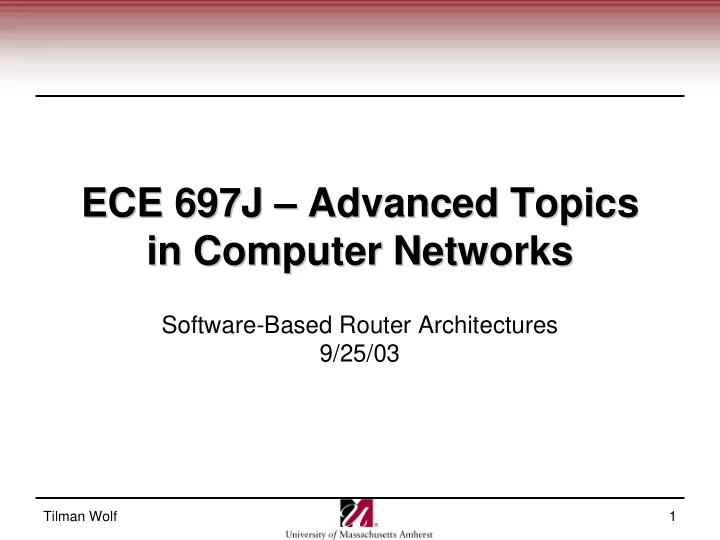

ECE 697J – – Advanced Topics Advanced Topics ECE 697J in Computer Networks in Computer Networks Software-Based Router Architectures 9/25/03 Tilman Wolf 1
TCP Connection Recognition TCP Connection Recognition • Track currently active connections • Algorithm: For each IP datagram with TCP segment { Extract IP source, S, destination, D, address Extract source port, P 1 , and destination port , P 2 Create/update entry in hash table C using (S, D, P 1 , P 2 ) as key If segment has RESET bit set, delete entry Else if segment has FIN bit set, mark connection closed in on direction Else if segment has SYN bit set, mark connection as established in one direction Delete entry if both directions are closed Mark completely established if both directions are established } Tilman Wolf 2
TCP Splicing TCP Splicing • On TCP connection establishment, node chooses random sequence number • When two connections are “spliced together”, sequence numbers need to be adjusted: • Need to keep offset between connections and adjust each packet: Tilman Wolf 3
Packet Processing in Software Packet Processing in Software • Can we write a packet processing application? – We could, but inefficient – OS has better access to hardware resources – OS can access packet data without copying • Embedded System – Stand-alone device – Software is optimized for particular task – No other functionality – Possibly difficult to program • OS Implementation – Packet processing part of OS kernel – Benefits: OS abstractions, device drivers, reusable for all users Tilman Wolf 4
Interrupts and Priorities Interrupts and Priorities • What is an interrupt? – Event that signals to operating system – Hardware interrupts: raised by device – Software interrupts: raised by software – “Interrupt handler” is called to process interrupt • Priorities – Interrupts have different priorities – Examples? – Higher priority interrupts can interrupt lower priority code – Kernel software can specify desired interrupt level Tilman Wolf 5
Packet Processing and Interrupts Packet Processing and Interrupts • Interrupt levels for packet processing: – Highest to device driver – Lower to protocol processing and application – Why? • Requires queues between interrupt levels – Why? • Processing in high interrupt should be kept brief • What if CPU cannot keep up? – Livelock • Only few priority levels supported Tilman Wolf 6
Kernel Threads Kernel Threads • Thread is piece of software that runs in its own context – Similar to process, just light-weight • Different threads can run in different priorities – More fine-grained than interrupt levels – Scheduling policy allocates CPU to threads • Thread synchronization handles access to shared data – Mutual exclusion: only one thread has access to data structure – Notification: thread blocks until event occurs • How should threads be assigned to protocol software? – One thread per layer – One thread per protocol – Multiple threads per protocol – Protocol threads plus timer management – One thread per packet Tilman Wolf 7
One Thread per Layer One Thread per Layer • Different layers have different priorities • Requires queues between layers Tilman Wolf 8
Per Protocol Threads Per Protocol Threads • Example: UDP and TCP • Each protocol has queue • Multiple threads per protocol: – Handle incoming and outgoing packets separately Tilman Wolf 9
Timer Management Threads Timer Management Threads • Timer management is fundamental functionality for all protocols • Timer thread handles all timers in system • Problem: timer can range from mircoseconds to minutes – Shorter timers need higher priority – Why? Tilman Wolf 10
One Thread per Packet One Thread per Packet • Layers introduce overhead – Queuing – Context switching • Requires many threads • Packet is processed entirely by one thread • “Run to completion” programming model Tilman Wolf 11
Asynchronous vs. Synchronous Asynchronous vs. Synchronous • Asynchronous programming – Program is structured around interrupts • Synchronous programming – Program is structured around threads – “packet centric” • Synchronous is easier to understand – Thread abstraction handles notification and mutual exclusion – Possibly less efficient – Probably less complex to understand Tilman Wolf 12
Next Class Next Class • Hardware-based router architectures – Read chapter 8 • Router design paper – Read paper Tilman Wolf 13
Recommend
More recommend